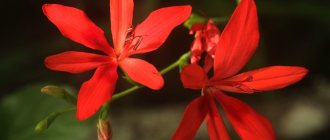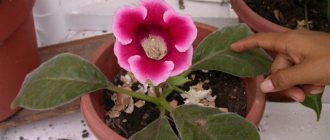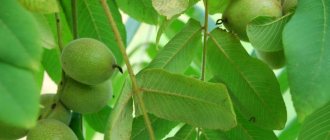Thyme is indispensable in the kitchen of a real housewife
Many people know the aromatic plant thyme as thyme, Bogorodskaya herb, lemon scent, boron pepper, and incense. The name “thyme” itself comes from the Greek “incense” (fragrant substances), which fully corresponds to the characteristics of the plant. This fragrant herb has a characteristic aroma, for which culinary specialists around the world use it as a spice, herbalists prepare medicinal infusions, and tea drinkers always add a pinch of dried thyme to their tea. Growing thyme is not difficult for both experienced and novice gardeners. Enjoy all the beneficial properties of this wonderful plant!

An original way to dry thyme

Thyme goes well with vegetables in both fresh and baked dishes.

This seasoning complements the taste of meat no less organically.
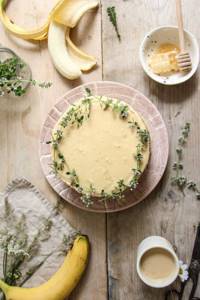
Thyme is often used to prepare various confectionery products.
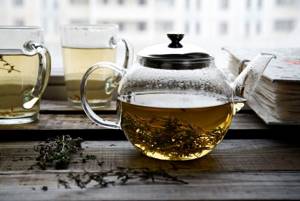
A very healthy healing tea is also brewed from thyme.
Description
The homeland of the herb thyme is considered to be Southern Europe. To preserve the beneficial properties of thyme, its branches are collected before flowering, that is, in June and early July.
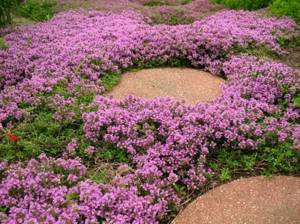
Its leaves are small, growing along the entire height of the shoots, which reach 15-25 cm. Depending on the variety of thyme, their shade can be rich green, from lilac to muted emerald.
The plant is unpretentious to climatic conditions, so it can be grown in Russia. The most important thing to consider is that it does not like high humidity.
Kinds
Common types of herbs:
- common thyme;
- creeping thyme;
- lemon thyme, the beneficial properties of which are appreciated by chefs in desserts and seafood dishes;
- caraway;
- flea;
- Ural;
- Siberian.
The most common herbs are common thyme and creeping thyme, a photo of which can be seen below.
The lemon type is used a little less often, and then the cumin type. The remaining varieties are practically not used in cooking.
Creeping thyme: varieties and varieties
Creeping thyme is a type of low-growing shrub. The height of the plant rarely reaches more than 15 cm. It is called so because of its ability to spread along the soil, forming a soft, fragrant carpet. The flowers have a bright purple hue and are collected in capitate inflorescences. This type is most often used by gardeners. It is used in landscape design because it blooms continuously all summer. The most common varieties of thyme are:
- "Colchis" - has light lilac flowers and spreads low (10 cm) along the ground;
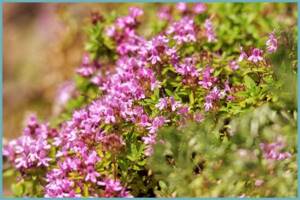
Variety "Colchis"
- “Donna Valley” - grows in a dense carpet, the leaves are bordered by a yellow stripe, the flowering is constant pink;
- “Silver Queen” - forms a rather high (20 cm) loose carpet, the leaves are gray with a white edge, the inflorescences are densely arranged and have a pale lilac tint.
Creeping thyme is a type of thyme, among which you can also find:
- Common thyme. A plant with a small height of 5-10 cm. The leaves below have a light fluff. Blooms are white and soft lilac.
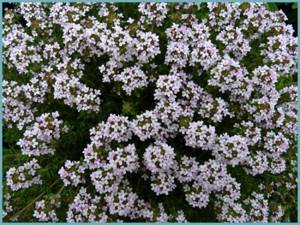
Common thyme - Lemon-scented thyme. It got its name due to its spicy aroma with subtle lemon notes, as well as the yellowish color of young leaves. The most popular varieties:
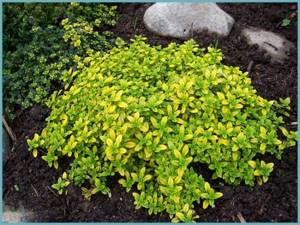
Lemon-smelling thyme- "Aurea" - has a bright yellow color;
- "Bertram Anderson" - has green leaves covered with yellow spots.
- Early thyme. It blooms earlier than others, but also fades a little faster. The following varieties are found in our country:
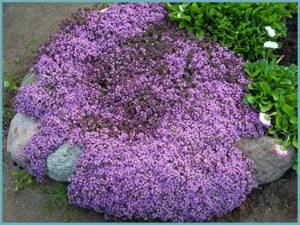
early thyme- "Minor" - characterized by the slowest growth and small fluffy leaves;
- "Pseudolanuginosus" - has sharp green leaves with excessive pubescence, blooms very profusely.
Use in cooking
To maximize the beneficial properties of thyme, it is recommended to use it fresh. However, dry thyme seasoning is also suitable for cooking. This won't make the taste any worse.
What dishes are they added to?
Thyme seasoning application:
Meat and poultry
(fresh and dried):
- fried;
- in the form of roast;
- stewed;
- Grilled;
- in the oven.
Soups:
(dry and fresh herbs):
- pea;
- mushroom;
- French onion;
- pumpkin;
- beet;
- various puree soups;
- pearl barley and others.
Second courses
(dry and fresh):
- vegetable stew;
- potato and zucchini dishes;
- pea and lentil puree;
- rice;
- pasta;
- egg dishes.
Other culinary uses:
- sauces;
- bread dough;
- marinades for poultry, fish and meat;
- vegetable preparations;
- tea.
Note! Thyme especially reveals medicinal properties in tea. This drink is useful for respiratory diseases, gastrointestinal problems, and sleep disorders.
Expert commentary

Daria Sakharovskaya
Founder and owner of the House of Spices and Herbs "World of Spices".
Ask a Question
Thyme is a versatile spice that can be added to almost any dish or drink. In order for thyme to be beneficial, it retains its taste and aroma, it must be collected on time, properly dried and stored.
How many grams
The table below shows the amounts of thyme and thyme in common measuring containers.
| Volume | Weight (grams) | Calorie content |
| 1 teaspoon | 5 | 5 |
| 1 tablespoon | 13 | 13 |
Thyme propagation
Reproduction of creeping thyme varieties in open ground is carried out in three ways:
- Seeds. Planting material is collected in the fall and dried until spring. Then they are sown and covered with film. It is also possible to plant seeds in the fall.
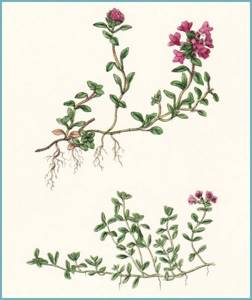
Pattern: thyme bush - By cuttings. This method is convenient because the seedlings are already strong. Cuttings are selected during spring or autumn pruning. The strongest of all are taken for planting. It is they who will subsequently form a new bush.
- Dividing the bush. A very painful method for the plant. When carrying out such propagation of thyme, the entire bush is dug up and divided in half. Special care is required. It is very important not to damage the root system, otherwise the plant may get sick or even die.
Chef's Tips
Daria Sakharovskaya
Founder and owner of the House of Spices and Herbs "World of Spices".
Ask a Question
Question to the expert
How to make the thyme spice maximize its properties in a fish steak?
It is recommended to fry it not in sunflower, but in olive oil. After cooking, add a little lemon juice.
How much thyme (thyme's Latin name) should I add to my dishes?
Depending on what exactly you are cooking. However, thyme is not used in large quantities.
When should you add thyme when cooking?
It takes time for a spice to reveal its flavor and aroma. Therefore, it is added at the very beginning of cooking.
Planting thyme
Planting takes place in two stages. First, in March, seeds are planted in a box and seedlings are grown. The seedlings are transferred to open ground in May. Flowering occurs all summer, starting from the second season after planting. When choosing a site, you should choose a well-lit area. If it is not available, a shaded place will do.
Soil that is best is alkaline or neutral with good drainage. Little fertilization is required, only poor soil, mulching is excellent. Thyme does not require much watering. Drying should not be allowed, but overwatering is also detrimental to thyme. Sanitary pruning is carried out every year.
At the beginning of the season, they make room for fresh shoots, and after flowering, cut off the old branches. Thyme can be propagated by seeds or vegetatively. Susceptible to attacks by bloodworms and weevils, and can be eaten by aphids. Overwatering the plant causes the plant to become infected with fungal diseases.
How to plant seedlings
You need to start growing seedlings in early spring. Before planting, small seeds are mixed with sand. The mixture ratio should be one to three.
The best soil for germination is a mixture of cactus soil and black soil.
The ratio is also one to three.
- The seed material is evenly scattered over the surface; it is good to add fertilizer from peat and sand mixed in half to the soil.
- Sprinkle sand carefully, in a thin layer.
- Next, spray the soil with a spray bottle and cover with film.
- It is better to place the container with seeds in a warm, bright place.
- The seedlings are grown for four months.
- It is necessary to keep the seeds indoors with good access to light.
- As soon as the first shoots appear, the film is removed and the seedlings are moved to a cool place. It is necessary to ensure good circulation of fresh air, but avoid drafts.
You need to moisten the soil regularly, without allowing the soil to dry out too much. Watering is done by spraying from a fine spray bottle.
Planting at home
As a rule, seeds are planted in small containers. The diameter of the pot should be less than 20 centimeters.
- A drainage layer of up to half a centimeter is placed at the bottom of the pot.
- A mixture of peat, black soil and cactus soil is poured on top.
- The soil needs to be moistened, seeds scattered on top, covered with a thin layer of a mixture of sand and substrate.
- The planting is sprayed with water and covered with glass or polyethylene. The pot is placed on the windowsill.
- It is better to choose the sunny side, but protect the seedlings from direct sunlight.
If all conditions are met, the first shoots will appear very soon. When seedlings appear, the covering material must be removed.
You need to spray the seedlings regularly, avoiding drying out.
After 8 weeks, all weak, thin shoots must be pulled out to give room for good shoots to grow. You need to cut the grass often to prevent it from blooming. Then the greens will always remain fresh, tasty and aromatic.
Look at this beautiful photo of thyme in a flowerbed:
Planting thyme outdoors
It is necessary to transplant the sprouted seedlings into fresh air from the fifteenth to the thirtieth of May. An area should be chosen that is well lit if possible. In the shade, with poor access to sunlight, the shoots stretch and do not gain strength.
Recommendations:
- The soil for planting should be looked for with a good drainage layer; it should be loose, rich in minerals, with a neutral or slightly alkaline pH. Waterlogged, poorly weeded soil threatens the formation of mold and fungal diseases. You will have to take care of additional drainage.
- Start preparing the selected area six months before planting, in the fall. Remove all excess vegetation, bushes, grass, roots.
- Then you need to dig up the ground and add fertilizer to it. Compost, rotted manure or phosphates are suitable for this.
- When the ground thaws, it’s time for replanting; the area needs to be weeded, the soil made loose and thoroughly watered with urea. A mixture is made - 20 - 30 grams of the substance are diluted in one liter of water. Seedlings are planted at intervals of twenty to twenty-five centimeters. Leave 40-50 centimeters between rows.
How to choose
If thyme herb is purchased fresh, you must pay attention to the appearance of the bunches. They should not show signs of damage from insects or diseases. The leaves look up rather than droop.
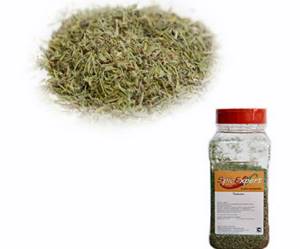
Dried thyme must be crumbly, without impurities. It must be completely dry, without signs of moisture.
Fertilizer and feeding
It is undesirable for thyme to add fresh manure to the soil. Growing thyme in open ground allows the use of wood ash. It will not only add nutrients to the soil, but also reduce acidity.
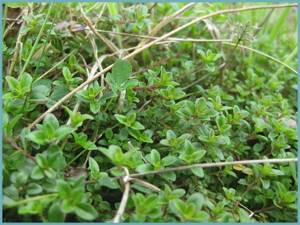
Feed the perennial with mineral fertilizers
The first fertilization of thyme is carried out with urea in early spring. If this is the first year, then before germination, and in the second and subsequent years during spring pruning.
Advice! Mineral fertilizers can be applied from the second year of life of creeping thyme.
Diseases and pests
Creeping thyme is very resistant to attacks by pathogenic bacteria and pests. Planting and caring for it is not difficult. It is unpretentious, but the only drawback is its slow growth.
The main pests of Bogorodskaya grass are:
- weevil;
- meadow moth;
- aphid;
- sandy sluggish.
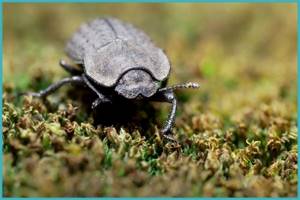
Sand slow beetle
Thyme can also be affected by some fungal diseases. This happens due to violations of agricultural cultivation techniques. Excessive watering, infrequent weeding, and shading of the plant lead to the spread of fungi on it.
Deep plowing, regular loosening of the root area of the soil, and timely weeding will save you from insect pests. Pests can also be removed by applying fertilizer containing lime or other alkaline fertilizers.
Creeping thyme: combination with other plants
Thyme looks great in group or joint plantings. It can be used as a background for plants with large textured leaves. Often they play on the contrast of colors in combination with heuchera.
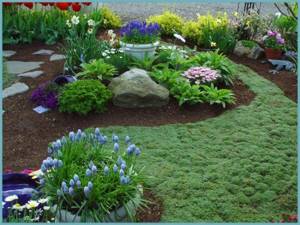
Thyme in landscape design
Creeping thyme attracts a large number of butterflies, bees and other pollinating insects with its powerful aroma. Therefore, it can be planted next to cucumber beds. By flocking to the smell of thyme, bees will help pollinate other vegetable crops.
Thyme or Bogorodskaya herb is the main component in the composition of bouquets made for the holiday of the Holy Trinity. These bundles also contain wormwood, mint and lovage. Since ancient times, it was believed that the combination of their aromas would drive away all evil spirits from the home.
What does thyme (thyme) look like and where does it grow?
The plant has been known for many centuries. In Ancient Greece, it was given special honors, believing that it gives life. Antibacterial, antiviral and fungal abilities surprised people of past eras and contemporaries. The grass has common characteristics:
- Low. The length of the shoots is from 5 to 35 cm.
- Shoots creep or stretch along the ground.
- The bark of the stems is brown.
- There are buds throughout the shoot.
- The peduncles have a villous surface.
- The leaves are strictly located opposite each other.
- Leaf color, shape and size depend on the variety.
- The color range of the buds is very diverse; the hybrids are the most colorful.
- The plant gives a constant aroma throughout the flowering period.
The second name - thyme (citriodorus) - translated from Latin means “incense” or “plant that produces incense.”
Thyme with vegetables and mushrooms
Thyme is a seasoning that perfectly complements baked vegetables and mushrooms. Its aroma stimulates the appetite, enhancing the aroma of cooked foods. It is also one of the components of the famous Herbes de Provence spice, which is added to fish, meat, potatoes and numerous other products.
In Italian cuisine, one can note such a feature that almost not a single recipe using mushrooms is complete without seasoning with thyme. Here is one of them:
Risotto with mushrooms

Necessary:
- dried porcini mushrooms – 200 g (can be replaced with champignons);
- meat broth - 1 liter;
- rice for risotto – 200 g;
- dry white wine – 100 ml;
- red onion – 2 medium;
- garlic – 3 cloves;
- dried thyme – 1 table. spoon;
- parmesan – 50 g;
- mascarpone – 50 g;
- salt pepper.
Place the dried mushrooms in a bowl and soak in boiling water for half an hour. Do not throw away the water remaining after soaking, we will need it later. Then cut the mushrooms into strips. Combine the broth and mushroom water in a saucepan and bring to a boil and leave over low heat without a lid.
Cooking process
At this time, chop the onion and garlic, place in a frying pan with heated oil and fry for no more than a minute. Place rice here too. When the rice becomes translucent, add the wine and simmer for another three minutes.
Now you need to gradually pour in and evaporate all the existing broth. Just add one ladleful at a time to the rice. This process usually takes about half an hour. At the final stage, when the rice is already cooked. Add remaining ingredients: cheeses, mushrooms and spices. Mix everything and cover with a lid for 5-10 minutes to allow the cheeses to melt.
Thyme is a spice that is part of most existing spices. Its versatility has made it a regular feature in many national dishes. If you like to experiment, try cooking your favorite food with a pinch of thyme.
Plant care
A perennial crop does not require complex agricultural technology. All that is required of a person is to select a suitable site and prepare it. In the future, the watering regime and fertilization are observed. Don't forget to remove weeds either.
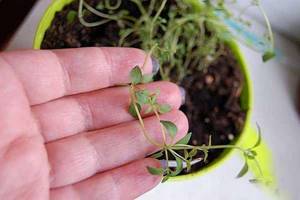
Watering
The plantings are constantly weeded so that weeds do not interfere with the growth of the crop. After watering, the soil must be loosened in order to avoid the formation of a soil crust. You should not overwater thyme, but it is also not recommended to keep the soil dry. It is necessary to exclude the possibility of the soil drying out; it should be soft, not wet. Despite the ability to withstand cold winters, light shelter will not interfere with the culture.
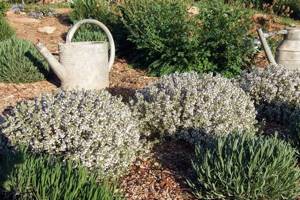
Top dressing
Thyme can be left without fertilizing, but if possible, the procedure is done. In early spring, urea is added, and when cutting greenery, azofoska is used. If thyme grows on the site for the second year, mineral fertilizers or mullein are added to the soil. The crop responds well to wood ash; periodic application reduces the acidity level. Thyme categorically does not like fresh manure.

Where is fresh thyme added for medicinal purposes?
In ancient times, thyme was considered a divine herb that returned not only health to a person, but also life. The ancient Greeks sniffed it like tobacco. Thyme herb is rich in essential oils, tannins and bitter substances, gum, flavonoids, mineral and organic salts. It contains a lot of vitamins A, B, C, magnesium, calcium, sodium, potassium, phosphorus, copper, selenium, zinc and iron.
Thyme is a good antiseptic, anti-inflammatory and analgesic, antispasmodic, and it also has a slight hypnotic effect. It is not for nothing that it is used in folk medicine. It is suitable for preparing decoctions, infusions, and baths. It relieves bronchitis, removes mucus, and has expectorant properties. It is sometimes used as a sedative and anticonvulsant.
Thyme essential oil is widely used in cosmetology. It is an excellent helper in strengthening hair and nails, which is why it is included in shampoos, lotions and balms.
How to collect thyme (video)
Interesting ideas:
- By planting a plant around gazebos, you don’t have to worry about annoying mosquitoes. Shake the flowers and the aroma will scare away the annoying inhabitants of the garden.
- Thyme lawns (English). They are formed in the spring, later they begin to change flowering depending on the variety. Lawns often have buds of different colors. The main thing is not to place them along the route, so as not to trample the beautiful leaves.
- Compositions with other varieties. They are planted under tall plants, among low flowers. Originally combined with carnations, dahlias, peonies.
- For the base of the rosary. A carpet of thyme will shade the main plant, which will be located in the center.
Thyme can be grown at home or on the property; the perennial bush will create an unusual mood and fill the garden with a pleasant aroma and fragrance. The healing properties of the bushes have not been disputed for many centuries, so both experienced and novice owners of dachas and houses want to grow it. The plant will decorate the area, give it a unique appearance and attract with an abundance of flowers.

